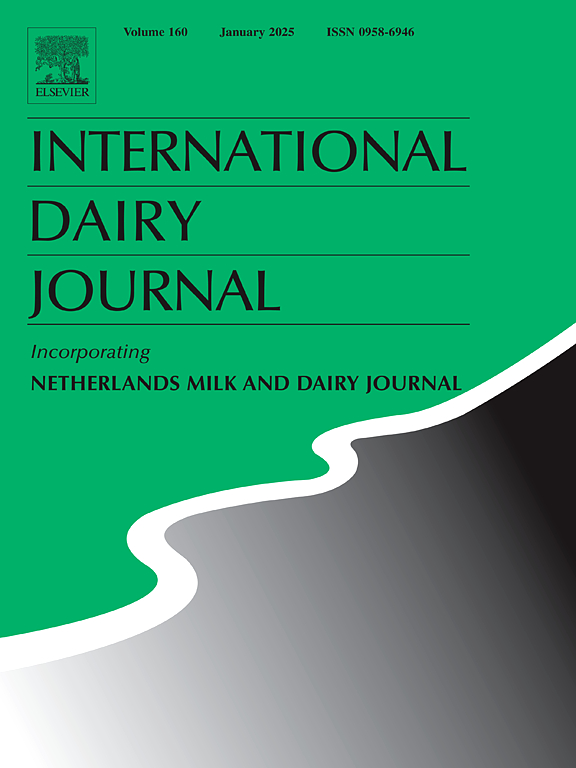Functional and technological effects of CLA-producing lactic acid bacteria in Minas Frescal cheese: Toward probiotic dairy innovation
IF 3.4
3区 农林科学
Q2 FOOD SCIENCE & TECHNOLOGY
引用次数: 0
Abstract
Consumer demand for healthier food options has sparked interest in conjugated linoleic acid (CLA) due to its potential health benefits. Dairy products naturally contain CLA, but levels often require enhancement. This study aims to identify CLA-producing bacteria and assess their efficacy in producing Minas Frescal cheese naturally enriched with CLA. We identified four CLA-producing bacterial strains from MRS broth, using three to create four cheese treatments: a control group (TTC) and three groups inoculated, respectively, with Lactococcus lactis subsp. lactis LL (TLL), Lacticaseibacillus rhamnosus LR (TLR), and Pediococcus pentosaceus PP (TPP). Analyses of proximate composition, pH, microbiology, and fatty acids showed that the cheeses met semi-fat criteria. Bacterial strains affected cheese characteristics like fat content, pH, color, and texture. While the study found that Lactococcus lactis subsp. lactis LL, Lacticaseibacillus rhamnosus LR, and Pediococcus pentosaceus PP cultures did not significantly enhance conjugated linoleic acid (CLA) levels in Minas Frescal cheese, it underscored their role in shaping the texture, color, and microbiota. These effects may directly influence the sensory attributes and microbiological stability of the cheese. Notably, TLL and TPP cheeses exhibited elevated counts of lactic acid bacteria, suggesting potential probiotic benefits. Moreover, the incorporation of Pediococcus pentosaceus PP represents an innovative strategy in dairy industry, contributing to the development of functional dairy products with enhanced health-promoting properties.
产cla乳酸菌在米纳斯壁画奶酪中的功能和工艺效果:迈向益生菌乳制品创新
消费者对健康食品的需求激发了对共轭亚油酸(CLA)的兴趣,因为它对健康有潜在的好处。乳制品天然含有CLA,但含量通常需要提高。本研究旨在鉴定产生CLA的细菌,并评估其在生产天然富含CLA的米纳斯壁画奶酪中的功效。我们从MRS肉汤中鉴定出4株产cla的菌株,用3株菌株制作了4种奶酪处理:对照组(TTC)和分别接种乳酸乳球菌亚种的3组。lactis LL (TLL)、lactoaseibacillus rhamnosus LR (TLR)和pedococcus pentsaceus PP (TPP)。对近似成分、pH值、微生物学和脂肪酸的分析表明,奶酪符合半脂标准。细菌菌株会影响奶酪的脂肪含量、pH值、颜色和质地等特征。而研究发现乳酸乳球菌亚种。乳酸菌LL、鼠李糖乳杆菌LR和戊糖Pediococcus pentosaceus PP培养物并没有显著提高米纳斯壁画奶酪中共轭亚油酸(CLA)的水平,而是强调了它们对质地、颜色和微生物群的影响。这些影响可能直接影响奶酪的感官特性和微生物稳定性。值得注意的是,TLL和TPP奶酪的乳酸菌数量增加,表明潜在的益生菌益处。此外,戊sacpedococcus PP的掺入代表了乳制品行业的创新战略,有助于开发具有增强健康特性的功能性乳制品。
本文章由计算机程序翻译,如有差异,请以英文原文为准。
求助全文
约1分钟内获得全文
求助全文
来源期刊

International Dairy Journal
工程技术-食品科技
CiteScore
6.50
自引率
9.70%
发文量
200
审稿时长
49 days
期刊介绍:
The International Dairy Journal publishes significant advancements in dairy science and technology in the form of research articles and critical reviews that are of relevance to the broader international dairy community. Within this scope, research on the science and technology of milk and dairy products and the nutritional and health aspects of dairy foods are included; the journal pays particular attention to applied research and its interface with the dairy industry.
The journal''s coverage includes the following, where directly applicable to dairy science and technology:
• Chemistry and physico-chemical properties of milk constituents
• Microbiology, food safety, enzymology, biotechnology
• Processing and engineering
• Emulsion science, food structure, and texture
• Raw material quality and effect on relevant products
• Flavour and off-flavour development
• Technological functionality and applications of dairy ingredients
• Sensory and consumer sciences
• Nutrition and substantiation of human health implications of milk components or dairy products
International Dairy Journal does not publish papers related to milk production, animal health and other aspects of on-farm milk production unless there is a clear relationship to dairy technology, human health or final product quality.
 求助内容:
求助内容: 应助结果提醒方式:
应助结果提醒方式:


